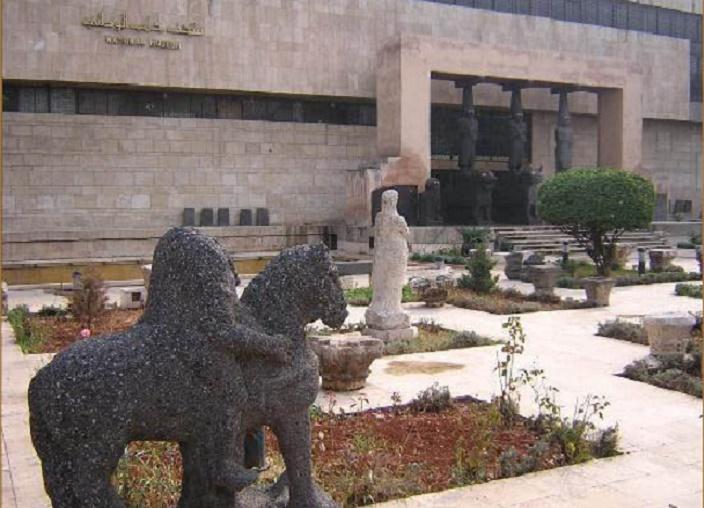In Syria, until the end of World War I, there was no museum in any of its cities, according to Bashir Zahdi, an archaeologist and a former Secretary of the Damascus National Museum until 2003.After the end of the war, it was established in Damascus (Diwan Al -Maaref), and one of the halls of the Adliya School building was allocated to it, and the Damascene families began to guide the Al -Waleed Museum their possessions, formed the nucleus of the first groups of the first museum in Syria.
The first museum in Aleppo
In Aleppo, the first museum was established in 1928, and with the beginning of 1945 it became one of three museums in Syria, with the Damascus and As -Suwayda Museum.In 1966, a decision was taken to demolish the ancient museum and replace it with a larger new building, which helped its expansion to include, in addition to the branch of the ancient East Archeology, as branches of classical monuments, Arab Islamic monuments, modern art, and prehistoric branch.
The National Museum of Aleppo became one of the most important museums of the world, due to the importance of its archaeological groups, located in the northwest of the old city of Aleppo, relatively close to the Bab Al -Faraj Tower Tower.
The interface of the palace
يقابل الزائر أمام بوابة المتحف الرئيسة نسخة من The interface of the palace الملكي في تل حلف، أما الأصلية فقد دمرت في برلين خلال الحرب العالمية الثانية عام 1945، وهي تعود إلى القرن التاسع قبل الميلاد (عصر الحديد)، وقد استخدم في تشكيلها الأسمنت الأسود المخلوط بالرمل والبحص الأسود مع شبكات حديدية.
The façade consists of huge statues, according to Antoine Mortghat, the founder of the current form of the science of ancient East, for three nymphic deities, and they are, the god of heaven and weather and his wife, the disappointments.
It is noteworthy that the Aleppo Museum was originally established to include the effects that were discovered in "Tel Half" in Ras Al -Ain, which includes the first revelation of the monuments of the Neolithic period, and the civilization attributed to it was called the Alliance's civilization, which is distinguished by the mixed pottery decorated with engineering and animal drawings.
Museum architecture
The museum building consists of two floors and a cellar, and two gardens are green surfaces, which include statues, stone sculptures and columns crowns, distributed in separate places, in addition to a building attached to the offices of the General Directorate of Antiquities and Museums, the building is connected to the museum's mass via a corridor on the ground floor.

read more
This section contains relevant folds, placed in (Related Nodes Field)
The Western façade is ahead of a head that leads to the museum lobby on the ground floor, in which a group of administrative rooms and exhibition halls spread in the inner courtyard are distributed, and the first thing that we look at the prehistoric wing of history, then the halls, Al -Jazeera Hall Hall, Mary, Hama, Ras Shamra and Tel are distributedAromati and Arslan Tash and Tel Ahmar, then finally the exhibition hall of the Kingdom.
As for the first floor, the wings are distributed from the Euphrates basin, then the classic, then Islamic effects wing, and finally the modern art showroom.
In the garden of the interior museum, a grave dating back to the third millennium BC was transferred from Tal Al Banat.As for its external garden, there are many statues of the Roman and Byzantine eras, including the Balasi stone from the tenth century BC, discovered in the temple of the weather god in 1929.
Museum wings
The museum is divided into five wings, prehistoric wing, and includes a group of artifacts dating back to the pre -writing period..The most prominent holdings are a skeleton of a niardetal human child, discovered in the Dederia cave.
The second wing is dedicated to the ancient Syrian antiquities (from the fifth millennium BC.M - 333 BC.M), and the Aleppo Museum is distinguished by the Damascus Museum with this wing, which contains a hall for each of the effects of Hasaka, Khabour and Raqqa, and the effects of the Kingdom of Mary, Ras Shamra, Tal Hallef, Arslan Tass (Hadato), Tel Hajib, the effects of Tel Ahmar, Tel Al -Khuira, Tel Barak and Ebla.
Among the most important exhibits is the statue of "Echop Elum", King of Mary, the statue.
As for the third wing, the Syrian antiquities of Greek, Roman and Byzantine covenants (333 BC.M - 636 AD), and it includes the effects of Manbij, and from the Al -Mina site in the Iskenderun Brigade and from the role of Urbis, and also includes gold, silver, bronze, copper, glasses and statues.
The fourth pavilion is dedicated to Arab and Islamic antiquities (636 AD - 1790 AD), and it includes pottery, glasses, money, weapons, shields, carpets, decorative homes, and a bomber for the old city of Aleppo.
Finally, a fifth suite devoted to modern art, and includes oil paintings for artists, most of them from Aleppo, such as Fathi Mohamed, Mahmoud Hammad and Naeem Ismail, the children's board and masks for the teacher of the teacher and the cotton cotton for Al -Louay Kayali and the love of Sami Burhan and the view of a lady of Alfraid Bakhsh and the face of a woman to Roland Khoury, as well as four paintings representingThe old city of an unknown artist lived in Aleppo in 1925.
At the beginning of the war, the Aleppo Antiquities Directorate protected the museum and its holdings by deporting the precious pieces that can be transferred to a safe place, and protecting the rest of the pieces, which are difficult to move, by surrounding them with sand bags, insulators and wood, and closed all halls and storage rooms with fire -resistant iron doors, and added to themConcrete pillars, according to a booklet issued by the General Directorate of Antiquities and Museums in 2016.
